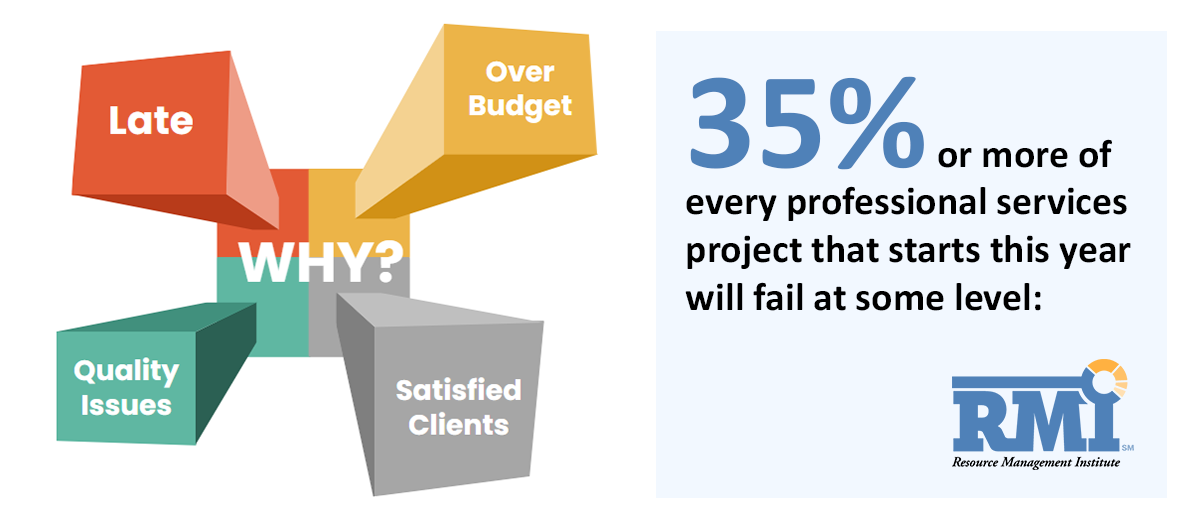Originally published on Deltek.com
According to research from the Resource Management Institute (RMI), over 35% of all professional services projects that start this year will fail at some level. Inefficient resource management is often the cause. Labor is the single biggest line item for professional services providers, but if you can’t get the right person, in the right place, with the right skills at the right time, your project performance and customer service are going to suffer.

With that in mind here are four best practices from Ryan Childers, Managing Director of RMI, an institute dedicated to helping professional services organizations become more efficient through the advancement of resource and workforce management.
1. ESTABLISH A RESOURCE MANAGEMENT OFFICE WITHIN YOUR ORGANIZATION
Over 45% of the firms surveyed during our Best Practices in Resource Management Webinar, did not have a documented resource management process in place. In addition, many of the firms who have hired dedicated resource managers, have unfortunately taken that role and relegated to a staffing function. Our first tip is to establish a resource management office withing your organization. Resource management is more than that just staffing, it involves activities such as:
- Identifying the types and quantities of resources needed for specific projects or tasks.
- Allocating resources based on priority, skills, availability, and project requirements.
- Monitoring resource utilization and making adjustments as needed.
- Forecasting future resource needs and planning accordingly.
- Implementing systems or software to track and manage resource utilization.
But it’s not enough to simply establish an office, you must provide training and continuous learning. According to recent data from RMI, an alarming 42% of resource managers were not trained in any sort of formal resource management processes. This lack of training leads to inefficiencies, employee satisfaction issues and retention challenges within the resource management office itself!
2. IMPLEMENT A DOCUMENTED RESOURCE MANAGEMENT PROCESS
Tip number two is to use a centralized, documented approach to resource management with enterprise-wide transparency for all available resources. Many organizations spend a lot of time, effort, and energy, trying to develop their own resource management processes because they feel as if their business or customers are unique. Instead of taking the time to develop a process from scratch, RMI recommends using an industry-standard approach like Just-in-Time Resourcing® (JITR) and then tweaking that to fit your individual business.
JITR is an industry-standard Resource Management solution developed by the RMI to help companies get the right person with the right skills in the right place at the right time. It is a derivative of Just-in-time (JIT) manufacturing, which is a manufacturing methodology aimed at reducing times within the production system as well as response times from suppliers and customers.
3. CREATE A SKILLS DATABASE
Part of that methodology should encompass the creation of a skills database that will include defining skills by role, implementing regular updates by employees, and conducting a proper valuation of employee data by management or SMEs. Creating a skills inventory is a fundamental building block of effective resource management. You can use this database to understand:
- Who you have?
- What they know?
- Where they are?
- Are they available?
- What they want to do?
Every firm will want to track different skills; however, a best practice here is to make sure to consolidate this laundry list as much as possible. If you have a list of 1000’s of skills the data set will become unmanageable. Make sure to organize into logical categories and sub-categories when possible.
4. MAKE SURE YOU HAVE ACCURATE FORECASTS
It’s impossible to plan your resources without accurate forecasting data. Forecasting future demand is vital for professional services to ensure they have the right amount of inventory or resources available at the right time. Here are a few tips to help make sure your forecasts are more accurate:
- Focus on 90 Days: Make sure you have an accurate 90-Day forecast. A 3 month forecast allows you to plan project timelines, resource requirements, and staffing needs more accurately. It gives you sufficient lead time to hire or reallocate resources to ensure projects are adequately staffed. Long-range forecasts of 180 days or more are important, however, they tend to be less accurate and therefore less useful.
- Make sure your forecasts look the same and are easily accessible. A good forecast is worthless if it’s not visible to the right people at the right time. Make sure your forecasts are easy to access and that they look the same. Make sure you have included all different drivers of demand and/or pipelines and import them into your forecast. In addition to your main sales team, other verticals may influence demand including support, services, and client relationship management.
